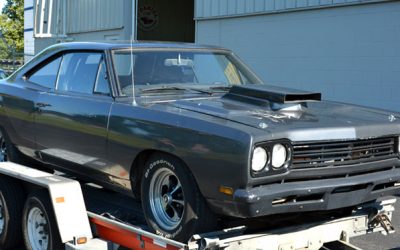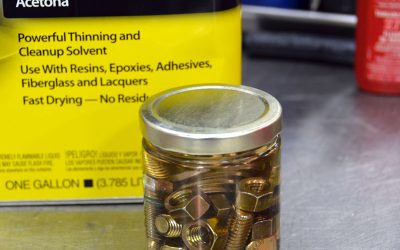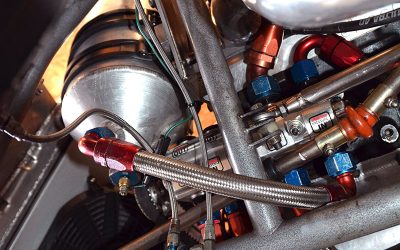Einstein was known to conduct thought experiments. He used his immense intellect to contemplatively conduct experiments without the necessity of spending time in the laboratory. Knowing how often this process worked is difficult to ascertain — but he certainly changed the world of physics. Seeing where things are headed in our industry, on both the commercial and motorsports sides, can be similarly difficult. Wander with me for a few minutes…
I remember the scrum that developed in the late eighties and early nineties over the Clean Air Act of 1990, which brought us OBD II in all its imperfect glory. Manufacturers were beside themselves over the technology and the information- and software-sharing provision that mandated including the aftermarket because they couldn’t envision the concurrent development of the Internet as a delivery vehicle. There was a real panic, which was a good example of how unknown unknowns influence behaviors.
Recently we’ve seen another thing thought to be improbable appear on the horizon: the feds’ attempt to shrink racing under the guise of clean air (which is still an open-ended battle with an uncertain outcome — Click the SEMA NEWS button for more information and to add your name to the petition if you’ve not done so already). This heavy-handed action represents another unknown unknown, an offshoot of the CAA of 1990 run amuck, but one that, if left unaddressed, could threaten a range of industries that support racing.
Borrowing from Einstein, I was sitting around the other day thinking things through and wondering where our industry is headed. It’s hard to imagine that the guys in the whalebone corset or buggy whip industries foresaw their demise, but I think we can make a case that the retail automotive sales and service industry faces challenging times. By extension, I believe this will eventually impact the performance industry since in many cases production cars provide the feedstocks for the racing world.
This all started when I picked up a piece from a “progressive†news source that said, “There is no constitutional right to the private ownership of any means of personal transportation.†It went on to state that the private ownership of automobiles and light trucks was a wasteful practice that squandered trillions of dollars of private wealth on the purchase and upkeep of a vehicle largely occupied by a single individual that consumed precious and limited resources while emitting harmful emissions that destroyed Mother Earth.
In addition to shedding our dependence on oil and saving the earth, I might presume that the goal would be to convert those personal trillions to tax income which would then be efficiently and effectively distributed by a kind and benevolent government to all manner of well-intentioned programs, but that would just be cynical.
We’ve seen these ideas floated before — it’s been suggested that the government be given access to all our private retirement accounts, our 401k’s and IRA’s, and bank savings. No point in all that money sitting around when it could be put to good use and replaced with a federally-guaranteed I.O.U., right?
These radical ideas pop up in the news, everyone screams bloody murder, the concept goes underground again, then resurfaces to less fanfare than the time before. The idea drops off the news cycle again and so on and so on until finally everyone is tired or bored of hollering about it and it gains traction and everyone buys the program. Got to love incrementalism…
This line of thought then dovetailed into Elon Musk and Tesla and his attempts to incrementally fracture the states’ various franchise laws (something I think that every manufacturer out there is secretly rooting for), which brought me to what I know about the changing retail industry, and suddenly all of these seemingly disparate bits were trying to align.
Let’s be honest, retail car sales is going to take a hit. The technology needed to meet the upcoming fuel mileage targets is going to be very expensive to invent, manufacture, and keep operational, and that expense will be passed through to the consumer.
Repairing technology is already expensive. I’m sometimes seeing repairs that are equal to 20% of a new purchase on some current-model technology-laden cars and trucks, and pricewise many 2016 model cars and light trucks already cost as much as a single family dwelling. Cheap money and long terms are the only things holding up the industry, but I think we can admit that that’s a poor strategy when buying a rapidly-depreciating asset subject to mechanical failure, rust-termites, and the phone-addled teen driver with the attention span of a gnat.
Technology isn’t always good; it’s making all of us worse drivers with built-in seven-inch center-stack video displays housing heating and air conditioning controls, radio, communications, and navigation that we have to voice command, touch-screen, or joy stick our way through as we move from system to system. Who needs to die in a flaming car wreck fiddling with a cell phone when we’ve built a bigger distraction right into the car? Distracted driving and poor skills are the impetus behind the autonomous car movement (So, now who knows where you’re going, how fast you’re driving, and how many people are in the car with you? Will that information be used to write you tickets via remote control? I’m just asking…)
Too many smart, networked systems with shared processing bouncing down the road while experiencing wild swings in temperature and humidity are already making repairs today part crap shoot and part capital investment. Can you imagine what happens when self-driving technology becomes routine? Can you imagine the liability exposure when repairing self-driving systems? Lawyers all over the world are licking their chops over this one.
Which caused my wandering mind to consider this next: Why do you suppose the factories are encouraging the move to online everything? Shop online, purchase online, arrange your loan online, make your repair appointment online. Are they training customers that they don’t need a dealership or a relationship with a real person at a brick-and-mortar business? And what about the concurrent effort to defund the dealer?
The volume bonus money that used to be paid at the time the inventory was ordered has become dependent on survey scores registered after the sale. Forbidding dealers to coach the customer on what response is needed at the risk of losing all bonus money, manufacturers have also made the qualifying scores impossibly high so that a dealer is rarely able to hit the mark to earn the extra income! Warranty claims from the service departments are now fought hammer and tong, even after jumping through hoops, complying with digital imaging requirements and getting pre-approval codes. I’m told this is common practice in both imports and domestics, across a number of manufacturers, which sounds a little conspiratorial, doesn’t it?
If more government control of our industry is part of the calculus, the fact is that from a regulatory point of view it’s going to be easier to control fewer centralized distribution centers than hundreds of franchised dealers and unaffiliated independent shops, so that plays out well for those who believe that government is the source of all things good and businesses are the work of the devil.
Now, for the consumer, collapsing the dealer body might pay dividends. Every employee at the factory sales and repair centers would be a corporate employee, subject to the policies, procedures and training requirements of the corporation, so from that perspective the quality of the customer’s experience might be enhanced since those policies could result in a more consistent and customer-focused culture (assuming the employee gives a damn, never a given in today’s society).
If every car sale were factory-direct at a fixed retail price, it would alleviate a good bit of angst for those who hate the negotiation dance; if the factory no longer had to pay a markup on the parts installed under warranty and if they only had to pay wages and benefits for warranty labor, then some of those billions and billions of dollars in new gross profit could be made available to extend the warranty period or invested into creating a truly superior product. Or, they could just grab the money and run — and I’m being cynical again. Sorry.
I think we are seeing the best days we are going to see right now, today, in our industries. The factory hot rods are spurring on new technologies and the American muscle car lives again. Superb manufacturing and machining techniques and innovation are everywhere in the performance aftermarket as this new generation of hot rods are being prepped and modified for the track. Thirty years from now if my dark musings become reality and we eventually see single-channel distribution, or mounting pressure from the True Believers forces us to abandon private ownership of automobiles, we may look back to these years and think, “I miss the good old days.â€
I sure hope I’m wrong.




0 Comments